Overview
The article titled "12 Digital Marketing Trends Shaping 2025 Strategies" addresses a pressing challenge that many brands face today: the need to adapt to rapidly evolving digital marketing landscapes. As we look toward 2025, it becomes increasingly clear that emerging technologies, shifting consumer behaviors, and the importance of ethical practices are not just trends but essential elements that can make or break a brand's success. This reality can be daunting, especially for tech startup founders who are striving to carve out their niche in a competitive market.
In this context, it is crucial to recognize the pain points that arise when brands fail to embrace these changes. Without leveraging tools like AI, personalized marketing, and multi-channel strategies, companies risk alienating their audiences and stunting their growth. This can lead to feelings of frustration and uncertainty, as the digital landscape continues to evolve at a breakneck pace.
However, there is hope. By embracing these trends and adapting strategies accordingly, brands can effectively engage their audiences and foster growth. This article emphasizes the importance of nurturing relationships with consumers through innovative approaches, ultimately guiding brands toward a brighter future. Together, we can navigate these challenges and emerge stronger in the ever-changing world of digital marketing.
Introduction
In a rapidly evolving digital landscape, many businesses find themselves grappling with the constant shifts in marketing strategies. This can feel overwhelming, especially as we approach 2025, where emerging trends—from innovative branding solutions to the integration of artificial intelligence—promise to redefine how companies connect with their audiences. It’s understandable to feel uncertain about how to navigate these changes. The pressure to not just survive but thrive in such a competitive marketplace can weigh heavily on your shoulders.
Yet, you are not alone in this journey. Many tech startup founders share your concerns and are seeking ways to adapt and grow amidst these challenges. The good news is that there are effective strategies to help you not only keep pace with these trends but also leverage them to foster deeper connections with your audience. By embracing new technologies and innovative approaches, you can position your business for success in this dynamic environment. Together, let’s explore how you can turn these challenges into opportunities for growth and connection.
RNO1: Revolutionizing Digital Marketing with Innovative Branding Solutions
In today's fast-paced digital world, many tech startups face the daunting challenge of . The struggle to maintain a strong brand presence can often feel overwhelming, leaving founders anxious about their growth potential. This is where steps in, offering compassionate guidance and innovative .
With , RNO1 ensures that businesses have , allowing them to adapt and thrive in an ever-evolving landscape. By prioritizing , RNO1 empowers companies to that resonate deeply with their target audiences. This strategic focus not only enhances customer engagement but also in 2025 and beyond.
Effective branding goes beyond mere visibility; it fosters that establish trust and loyalty. RNO1 understands the importance of these elements, positioning itself as an invaluable ally for businesses eager to succeed in the competitive digital marketplace. Together, we can , ensuring that your brand not only survives but flourishes in the digital age.
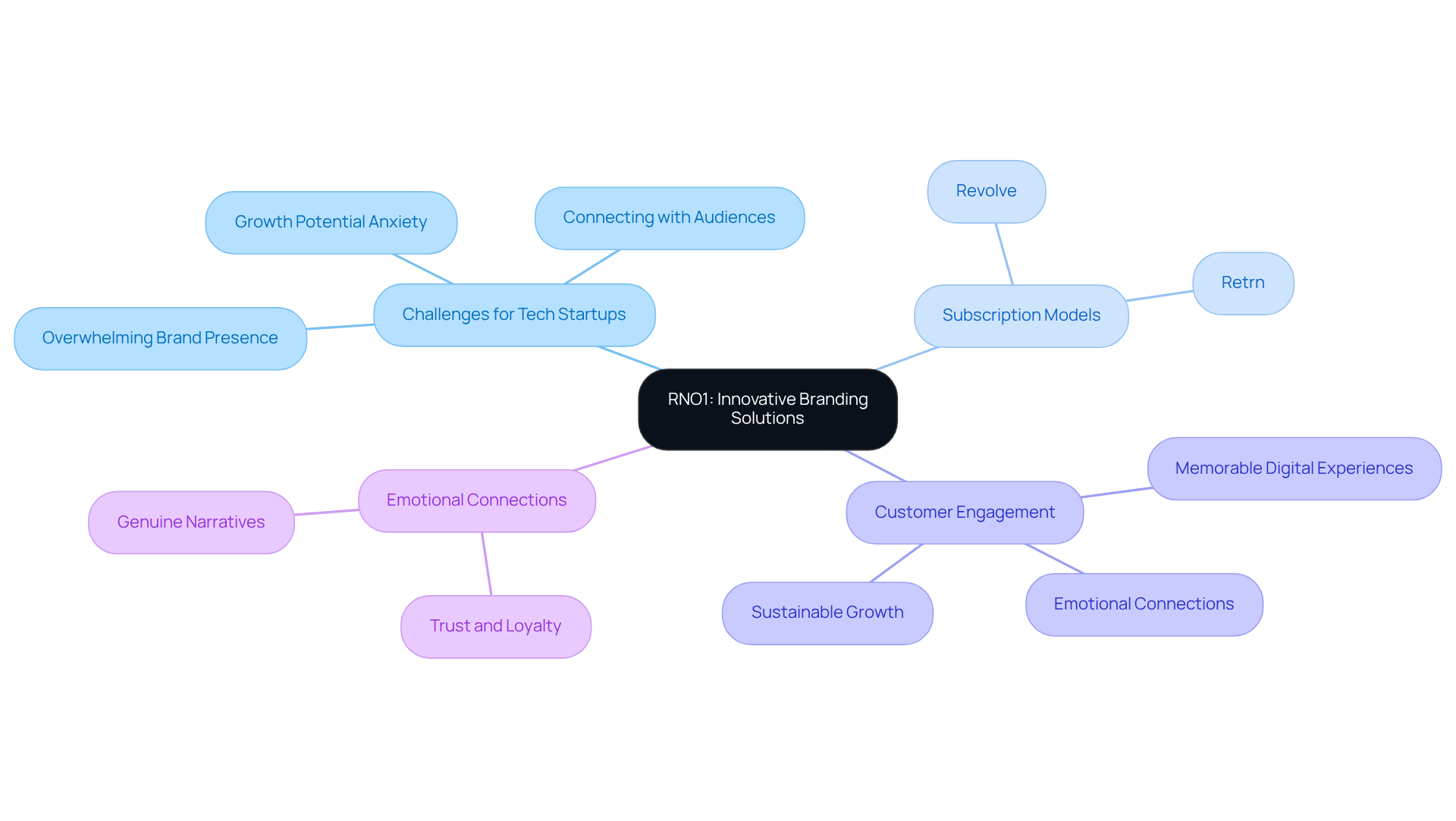
Artificial Intelligence: Transforming Marketing Strategies and Customer Engagement
In today's fast-paced digital world, many companies struggle to connect with their audience effectively due to the rapidly changing . The challenge lies in understanding consumer behavior and preferences, which can feel overwhelming. At RNO1, we recognize the pain points that face and are here to help. By harnessing the power of , we empower companies to examine their audience with unmatched precision. Our results-oriented approach focuses on achieving meaningful outcomes through that enhance personalized interactions, automate promotional processes, and provide insightful predictive analytics. This not only allows companies to adapt their strategies to the ever-changing needs of their audience but also fosters .
Consider the firms that have embraced AI technologies; they have reported . Research indicates that tailored promotions can boost conversion rates by as much as 10%. Moreover, a recent McKinsey report revealed that 40% of executives plan to increase their AI budgets to fully leverage its potential. This shift underscores the importance of adopting AI tools for companies aiming to stay competitive in an evolving landscape shaped by digital marketing trends. As Ginni Rometty, former CEO of IBM, wisely noted, . Similarly, Sundar Pichai, CEO of Google, advocates for AI as a complement to human skills, reinforcing the idea that .
As companies increasingly adopt these advanced technologies, they not only improve client engagement but also align with digital marketing trends, optimizing their promotional efforts and leading to a better return on investment (ROI). At RNO1, we are deeply committed to maximizing product visibility through our (RODD) strategies. By specifically utilizing AI tools, we ensure our clients achieve measurable success in their promotional endeavors. Together, we can and foster lasting connections with your audience.
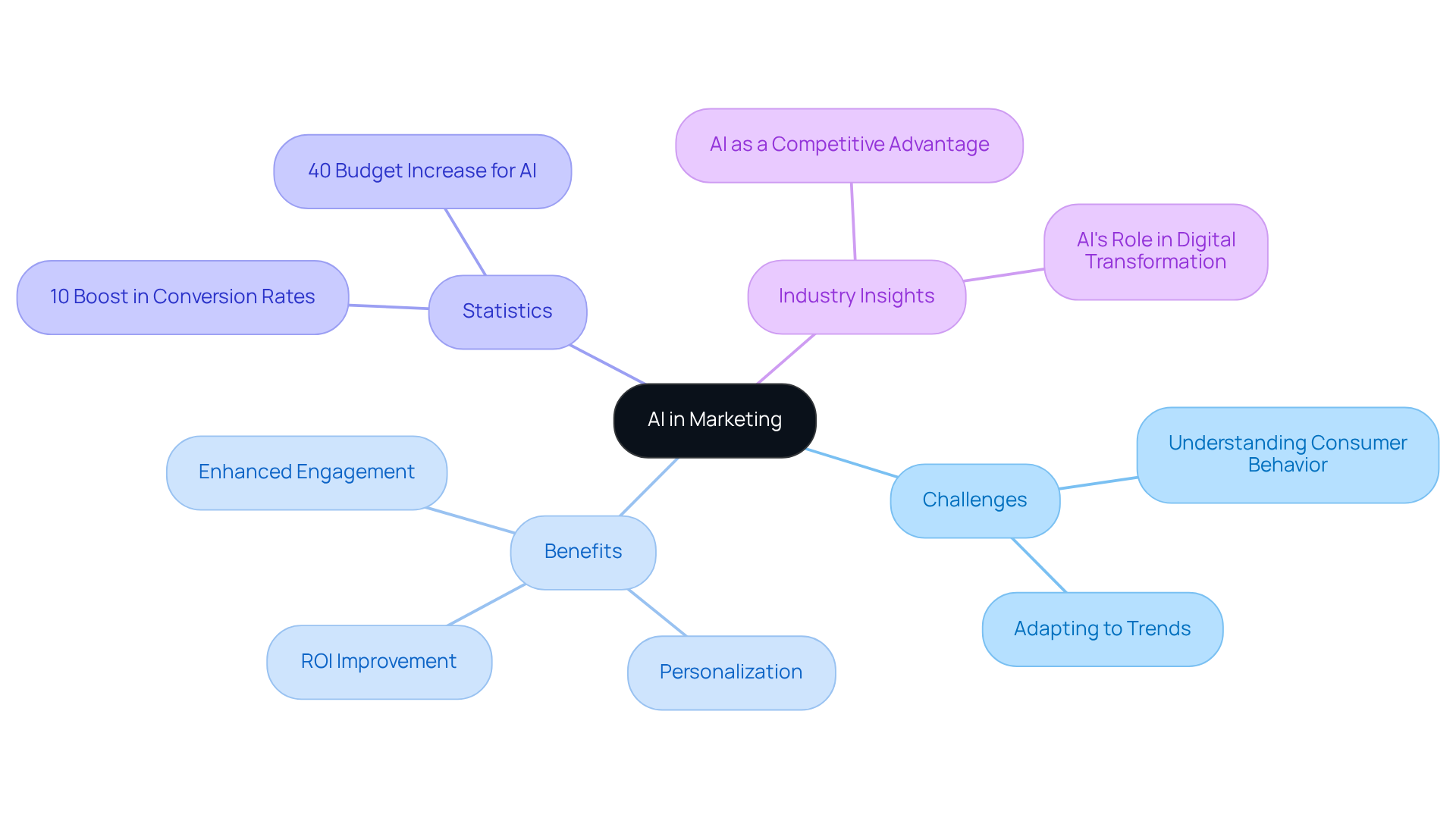
Personalized Marketing: Enhancing Customer Experience Through Tailored Strategies
presents a striving to connect with their audiences. In a world where consumers are bombarded with generic messages, the struggle to provide tailored experiences that resonate with individual preferences and behaviors can feel overwhelming. This disconnect not only affects client satisfaction but can also hinder loyalty, leaving clients feeling overlooked and unappreciated.
Consider the approach taken by companies like Sephora, which has successfully implemented personalized strategies through its Beauty Insider program, offering . Such efforts are not just beneficial; they are essential. In fact, that is 29% higher than their non-personalized counterparts, underscoring the effectiveness of this approach.
As we look ahead to 2025, a striking 64% of consumers will deem personalization crucial, highlighting its growing importance in marketing strategies. often see significant increases in conversion rates and improved client retention, especially when one considers that acquiring new clients can be up to five times more costly than .
Experts emphasize that , enabling brands to move beyond generic messaging and deliver relevant, meaningful communications. Yet, the path to effective personalization is not without its hurdles. Marketers frequently encounter obstacles, such as insufficient technology and tools, which can impede their efforts.
As we approach 2025, the focus on will be more critical than ever, as brands strive to create exceptional user experiences that foster lasting connections. To embark on this journey of personalized marketing, businesses should begin by analyzing to uncover preferences and behaviors, paving the way for communications that truly resonate with their audience. Together, we can navigate these challenges and embrace the to build deeper, more meaningful relationships with clients.

Short-Form Video Content: Capturing Attention in a Fast-Paced Digital World
In today's fast-paced digital landscape, companies often face the challenge of quickly and effectively connecting with their audiences while adapting to . , propelled by platforms like TikTok and Instagram Reels, emerges as a vital solution. These bite-sized videos enable companies to convey concise messages, capturing attention in a world where distractions abound. By embracing the power of short-form videos, businesses can , showcase products dynamically, and .
As we look toward 2025, it's anticipated that , with 45.5% of U.S. users expected to make purchases directly on the platform. This statistic highlights TikTok's role beyond mere entertainment—it's also a . Companies that have embraced creative content approaches, particularly those utilizing , report enhanced customer loyalty and awareness. These successes often stem from , especially when paired with influencer collaborations.
Experts emphasize the importance of tailoring strategies to align with digital marketing trends and the unique characteristics of each platform. For instance, TikTok boasts a far , indicating that companies can achieve more meaningful interactions by customizing their content to resonate with the platform's audience. Marketing leaders advise that understanding customer preferences and creating relatable content are essential for maximizing engagement in line with current digital marketing trends.
Brands like Amazon and Nike exemplify how effectively leveraging these platforms can boost visibility and engage with younger audiences. Their experiences demonstrate the potential of short-form video content to enhance awareness and foster interaction. By consistently innovating, responding to audience feedback, and expanding their omnichannel ambassador programs, companies can maintain relevance and nurture lasting connections with consumers in an increasingly competitive landscape.
As you navigate these challenges, remember that you are not alone. in crafting strategies that resonate with your audience, ensuring you can thrive in this dynamic environment.
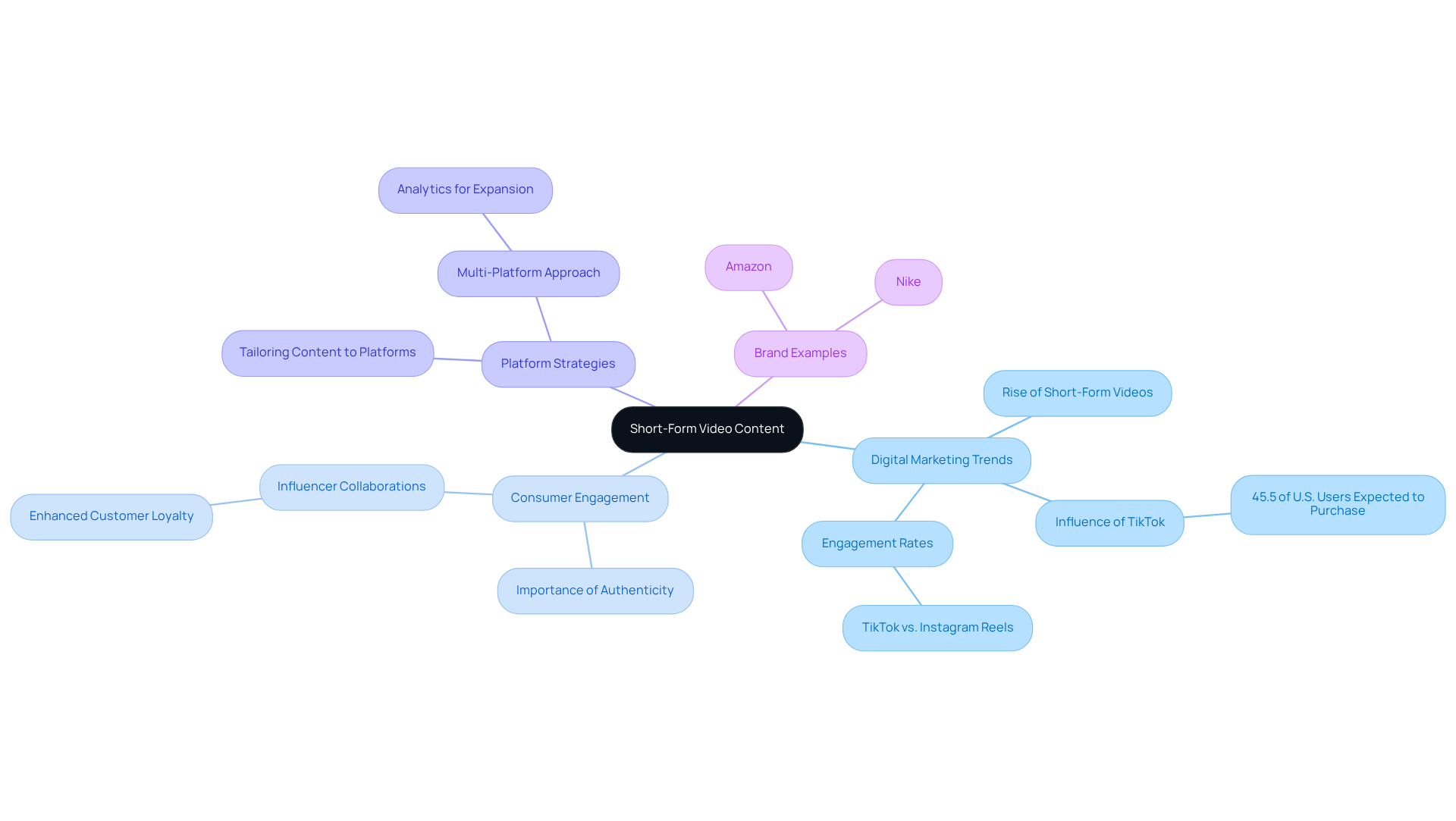
Multi-Channel Social Media Marketing: Engaging Audiences Across Platforms
Navigating the complexities of multi-channel in light of current can be daunting for many companies. Engaging audiences across platforms like Facebook, Instagram, Twitter, and LinkedIn often feels overwhelming. The challenge lies not only in reaching these diverse audiences but also in crafting messages that resonate with their unique preferences and behaviors, which is increasingly important in the context of digital marketing trends. This is where a becomes essential. By aligning messaging and branding, companies can significantly enhance their reach and visibility, fostering with their audience.
Imagine the impact of effectively connecting with various audience segments, customizing content that speaks directly to their needs. This thoughtful approach not only raises awareness of your company but also , creating a community around your brand. stands as a testament to innovative strategies that scale omnichannel ambassador programs, enhance through influencer partnerships, and drive measurable success.
Consider this: nearly 76% of local enterprises are already utilizing social media for promotion, and about 80% of marketers worldwide are leveraging Instagram for business visibility. The evidence is clear— profoundly impacts visibility. As we look ahead to 2025, companies that prioritize genuine interactions and consistent messaging across channels are likely to experience remarkable growth in their online presence and customer loyalty, reflecting the latest digital marketing trends.
As Neal Schaffer wisely states, 'Content is king, but . And she rules the social media kingdom.' Embracing this philosophy can transform your approach, fostering not just a brand but a thriving community. We invite you to share your experiences and thoughts on this journey, as together we can navigate the ever-evolving landscape of social media marketing.
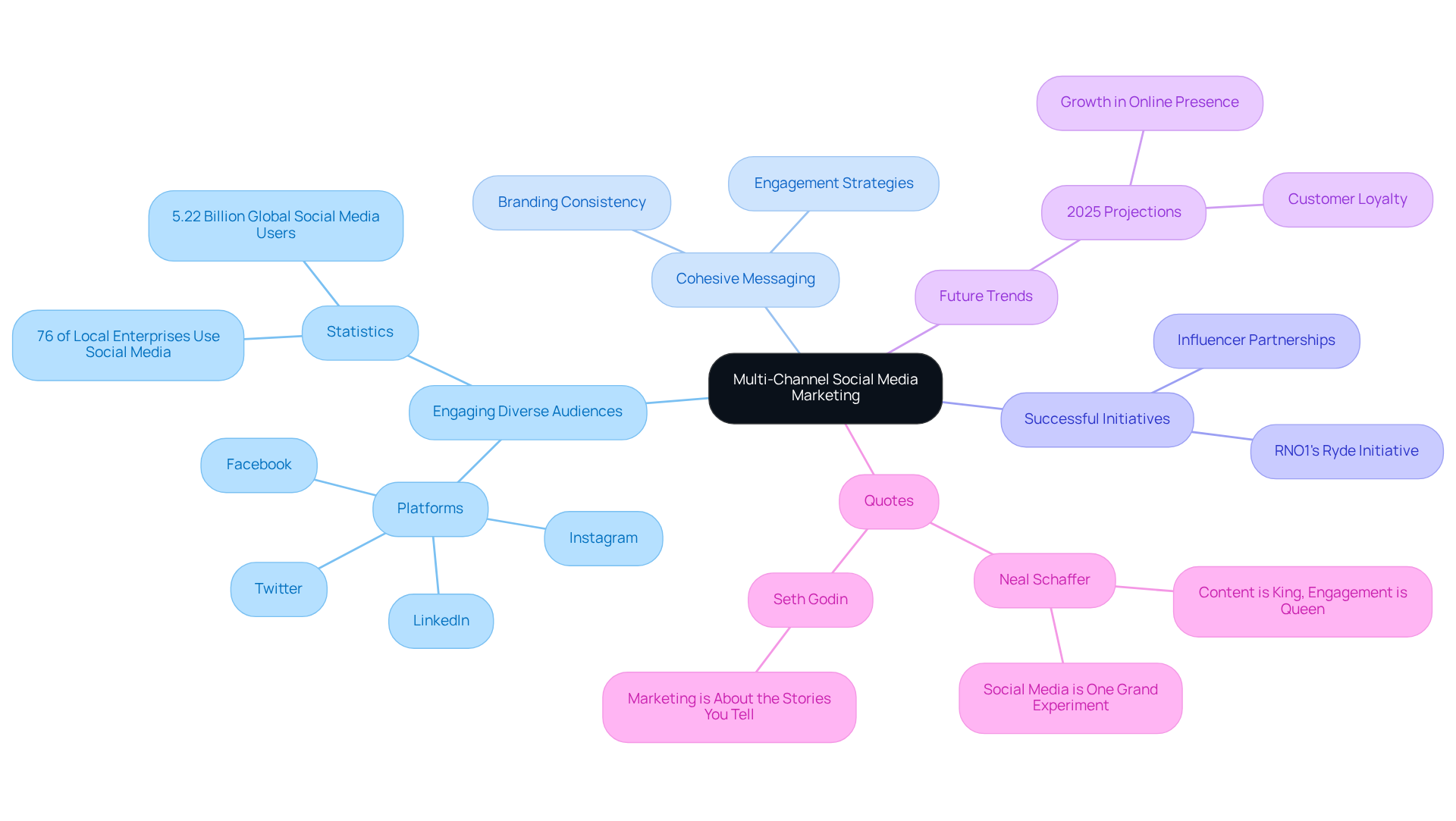
Voice Search and Commerce: Adapting to New Consumer Interaction Methods
and commerce are reshaping how consumers interact with companies, presenting a challenge that requires a thoughtful shift in and promotion strategies. It’s concerning to note that approximately one-third of the U.S. population—around 111.8 million people—are utilizing voice search features. This makes it essential for companies to optimize their content for these voice inquiries. By prioritizing natural language processing and conversational keywords, businesses can significantly improve their visibility in voice searches.
The introduction of is transforming the shopping experience in profound ways. For example, a Narvar report reveals that 43% of voice-enabled device owners are using their devices for online shopping. This trend indicates a growing inclination towards voice-assisted purchasing, which is exciting yet requires attention. As continues to surge, with forecasts suggesting that nearly three-quarters of U.S. households will have at least one smart speaker, the opportunities for voice commerce are vast.
Looking at successful instances of voice commerce integration, we see its tangible effects on . In 2021, it was anticipated that 34.7 million U.S. consumers would shop using smart speakers, a figure expected to rise by 9.3% to 38 million the following year. This upward trend highlights the necessity for marketing strategies to evolve and incorporate in line with digital marketing trends. As consumers increasingly favor voice queries over traditional typing, adapting to this change is not just beneficial, it’s essential.
Moreover, the speed at which voice search results are delivered—averaging 4.6 seconds compared to 8.8 seconds for traditional searches—greatly enhances user satisfaction. This efficiency encourages more frequent use, as noted by Backlinko. With 51% of online shoppers in the U.S. relying on , companies that effectively harness voice technology can profoundly influence consumer purchasing habits.
As we look ahead to 2025, the impact of voice commerce on consumer behavior is set to grow even further. It’s crucial for companies to embrace these technologies now. By focusing on creating seamless voice interactions and optimizing for voice search, businesses can cultivate a shopping experience that is not only engaging but also meets the evolving expectations of today’s consumers. Together, we can navigate this exciting landscape and build a future where technology enriches our daily lives.
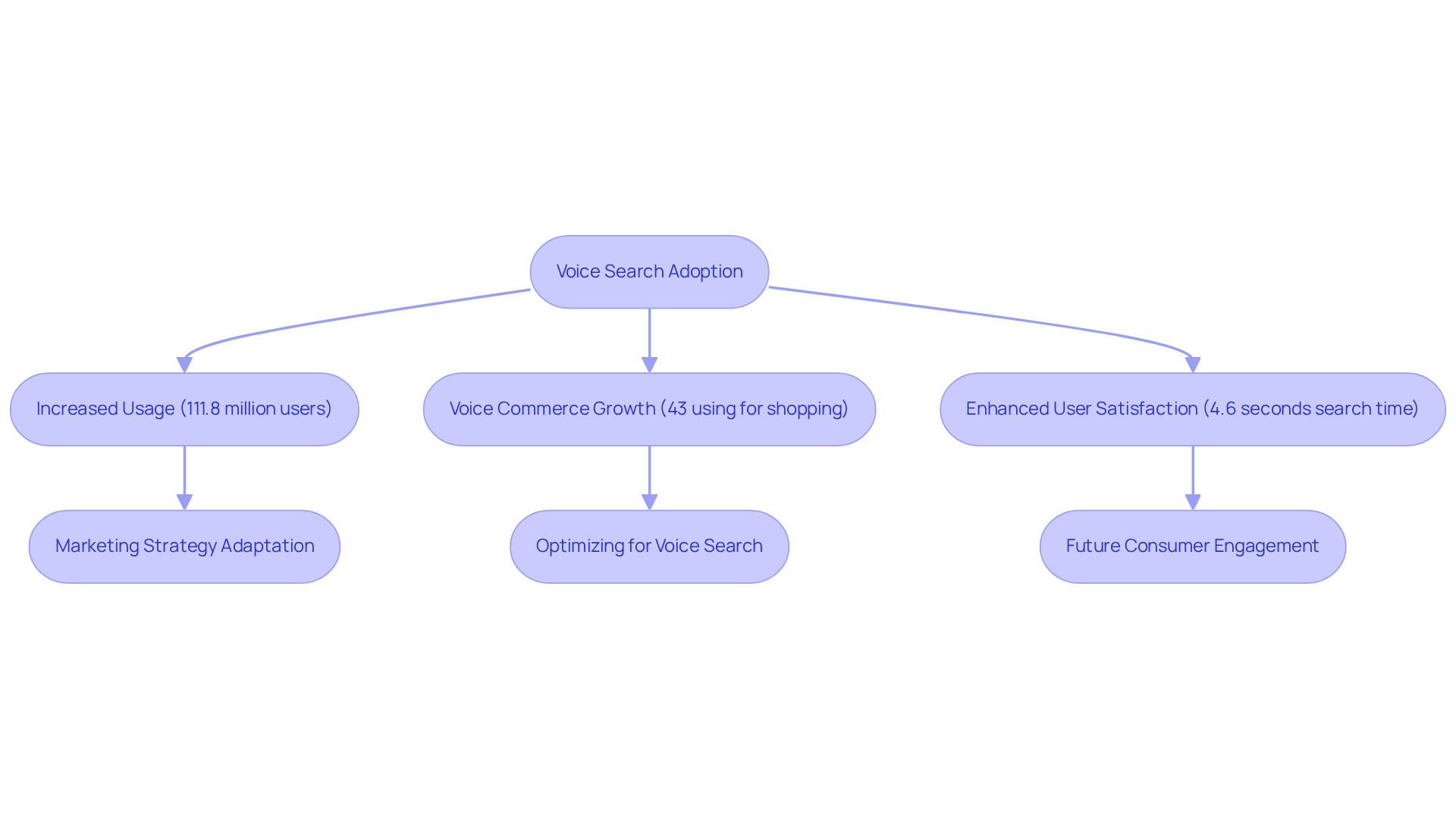
Ethical Marketing: Building Trust Through Transparency and Responsibility
Ethical promotion increasingly revolves around and responsible practices. As consumers grow more discerning about , it becomes essential for companies to ensure their values resonate with their audience. This alignment requires clear communication regarding sourcing, production processes, and promotional strategies. For instance, companies like Patagonia exemplify this commitment by openly addressing their . Similarly, Everlane's 'Radical Transparency' and Levi's 'Water<Less' initiative showcase that enhance reputation and cultivate .
Looking ahead to 2025, the necessity for openness in promotion will only intensify, as consumers expect companies to operate with honesty. Research reveals that:
- 71% of consumers would cease purchasing from a company if trust is compromised.
- 81% believe an organization’s data practices reflect their overall treatment of customers.
This underscores the urgency for companies to embrace that prioritize honesty and accountability.
Expert insights further emphasize this perspective; a robust ethical stance not only enhances overall company perception but also fosters resilience during public relations challenges. As one specialist noted, "A strong ethical position enhances overall image perception across various dimensions." By embracing transparency, brands can nurture deeper connections with their clients, ultimately paving the way for sustainable growth and loyalty. As the landscape evolves, those who prioritize ethical marketing will set themselves apart in a competitive marketplace.
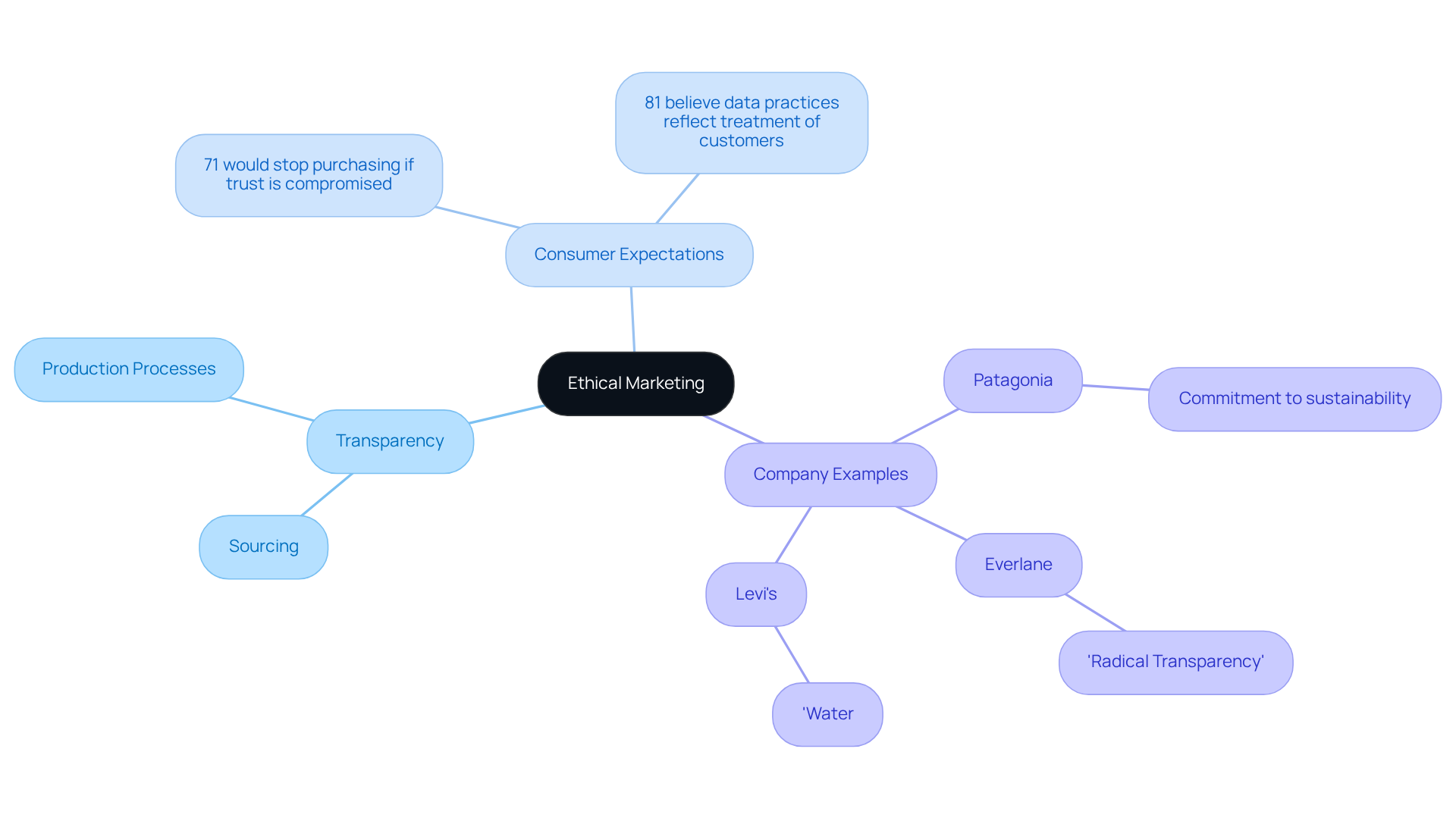
Social Commerce: Integrating Shopping with Social Media Experiences
Social commerce is reshaping the way we shop, addressing the common frustration of navigating multiple platforms for purchasing. Imagine discovering a product on social media and being able to buy it without the hassle of switching apps. This innovative approach not only simplifies the shopping experience but also brings joy to consumers, who can now explore and purchase seamlessly.
Brands are recognizing the importance of this shift, using the vast reach of social media to create and collaborate with influencers. This strategy not only boosts visibility but also makes the easier and more enjoyable for consumers.
It’s heartening to see that around 92% of TikTok users feel inspired to take action after seeing an ad, highlighting the platform's power in turning engagement into sales. With over available globally, businesses are increasingly weaving shopping features into their , allowing consumers to make purchases right where they feel most comfortable.
As we look ahead to 2025, the influence of social commerce on is set to expand in line with . Those who embrace these tools will not only enhance their visibility but also foster deeper connections with their customers, paving the way for success in a competitive digital marketplace. Together, we can navigate this evolving landscape and thrive.

Customer Experience: Prioritizing Engagement and Satisfaction in Marketing
In 2025, many companies face the pressing challenge of prioritizing to boost engagement and satisfaction. It’s essential to understand client journeys and pinpoint pain points, as these are crucial steps in fostering smooth interactions. By offering exceptional experiences at every touchpoint, businesses can nurture loyalty and encourage repeat patronage.
Notably, 81% of organizations recognize as a , highlighting its significance in . Establishing robust feedback systems allows companies to , paving the way for continuous improvement and adaptation to evolving consumer expectations.
Companies with , such as those developed through , see a 10% increase in average order value. This clearly illustrates how focusing on client experience can yield tangible business benefits. This proactive approach not only enhances but also empowers companies to thrive in an increasingly competitive landscape.
As Jeff Bezos wisely noted, 'If you create a great experience, clients share that with one another. Word of mouth is very powerful.' Moreover, with 92% of clients likely to depart after two or three negative interactions, the urgent need for businesses to focus on user experience to retain their clientele becomes evident.
Additionally, 86% of purchasers are willing to pay more for an , serving as a compelling incentive for companies to invest in refining their service strategies in line with digital marketing trends through innovative influencer collaborations and community engagement.
Together, these insights remind us of the profound impact that attentive, can have on both client satisfaction and business success.
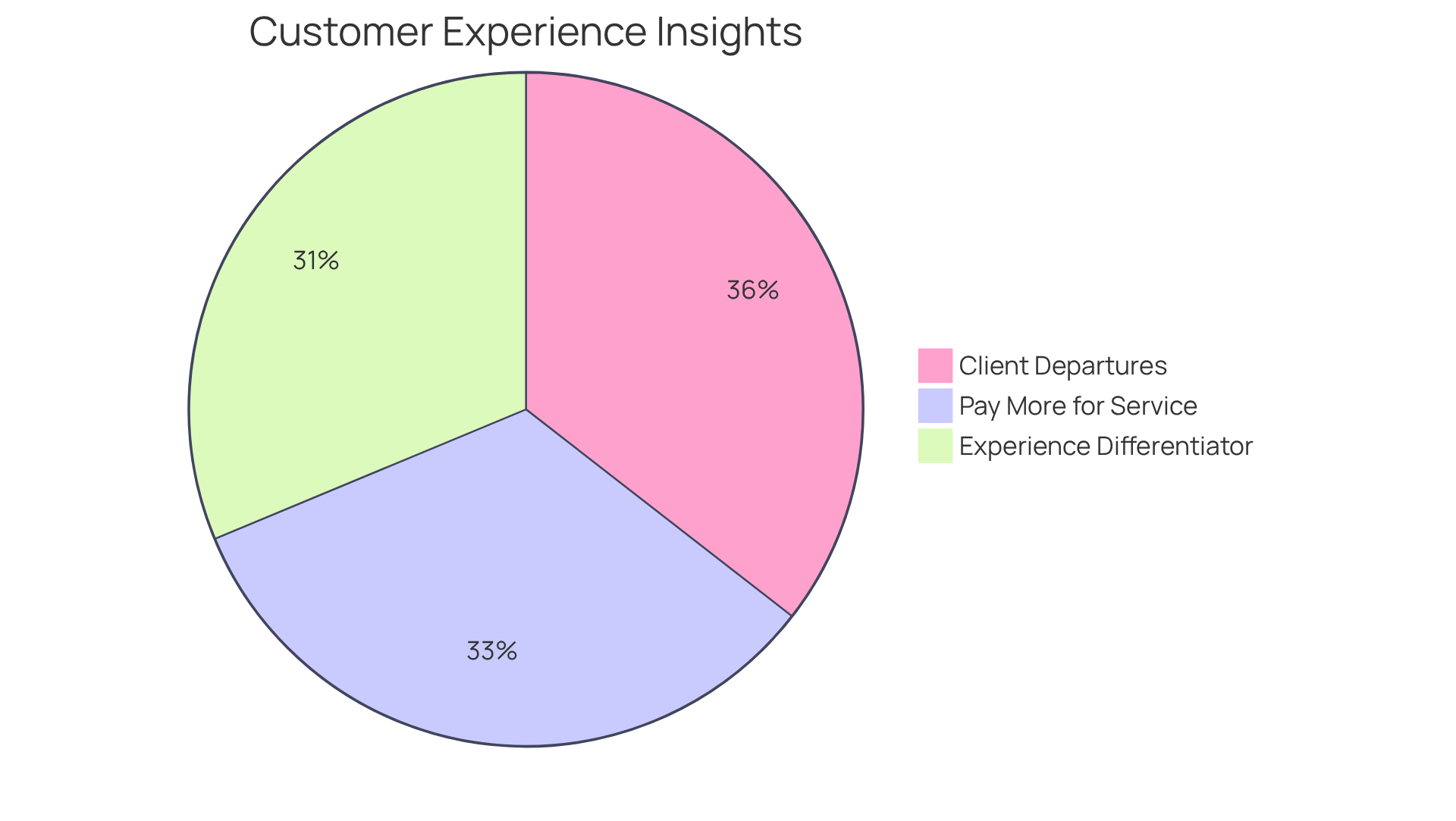
Augmented and Virtual Reality: Enhancing Engagement Through Immersive Experiences
In today's fast-paced world, many brands struggle to engage consumers effectively. This challenge can lead to missed opportunities and a disconnect between businesses and their audiences. However, offer a nurturing solution, by providing that truly captivate. Imagine a world where brands can create interactive campaigns, virtual try-ons, and that enhances the buyer journey—this is the promise of AR and VR. By incorporating these technologies, companies can not only distinguish themselves in a crowded market but also create memorable experiences that resonate deeply with consumers.
As Michael LeBoeuf wisely noted, 'A satisfied customer is the best business strategy of all.' This highlights the in fostering loyalty and building . Moreover, studies reveal that 82% of consumers favor tailored experiences, which AR and VR can distinctly offer. This personalization significantly influences their product selections and willingness to spend more. The findings from the case study on 'The Power of Personalization' further emphasize how vital are in shaping consumer choice.
By prioritizing these immersive technologies, companies can and establish themselves as leaders in the competitive landscape of 2025. Let’s embrace this opportunity together, nurturing connections that not only but also support the emotional needs of consumers.
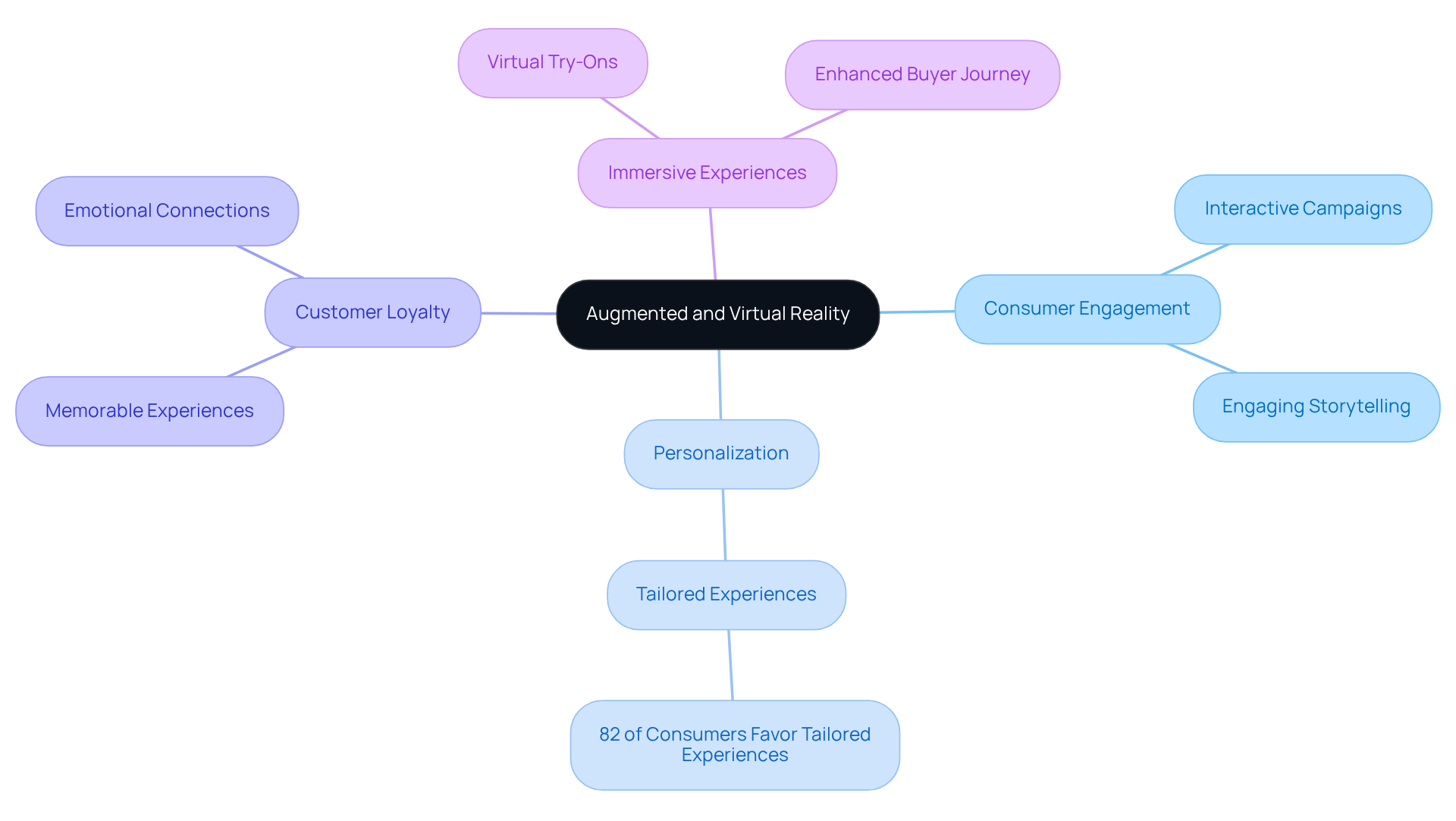
Inclusive Marketing: Embracing Diversity to Connect with Broader Audiences
In 2025, , as it focuses on embracing diversity to ensure that marketing messages resonate with a wide array of audiences. The challenge lies in authentically representing various cultures, backgrounds, and identities. When companies fail to do so, they miss the opportunity to and connection among consumers, which can lead to disengagement and a lack of loyalty.
However, by adopting , businesses can not only enhance customer loyalty but also . This positions them as relatable and trustworthy in the eyes of their audience. Experts highlight that inclusive promotion fosters positive social change and strengthens connections with diverse consumer segments.
Companies like Nike and Dove serve as inspiring examples, showcasing that resonate deeply with their audiences, ultimately driving engagement and loyalty. cannot be overstated; it is crucial for companies aiming to succeed in a progressively diverse marketplace.
By prioritizing inclusivity, businesses can create a more welcoming environment that invites all consumers to share their experiences and feel valued.
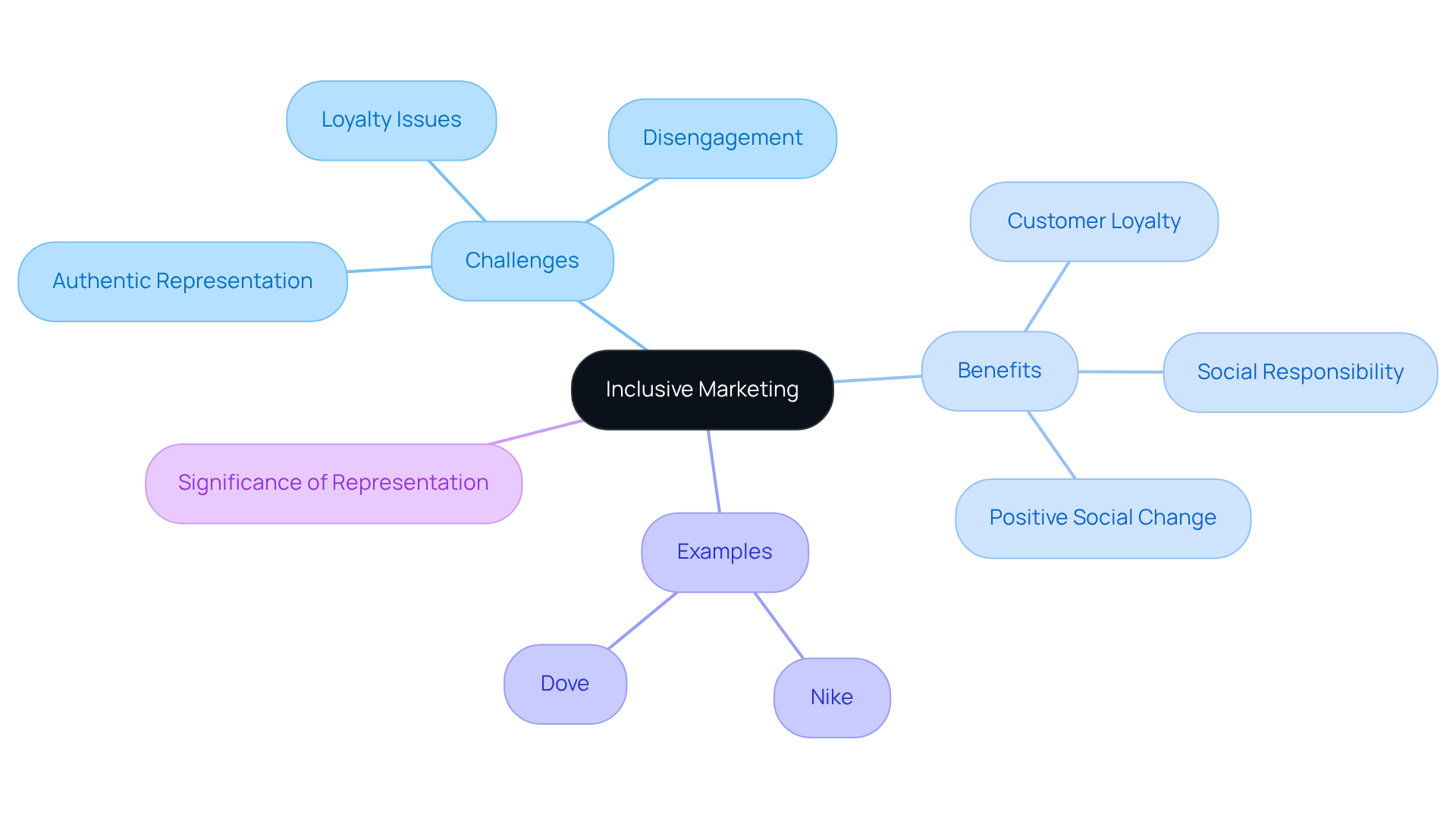
Google Analytics 4: Leveraging Data for Enhanced Marketing Insights
In today’s fast-paced digital world, many companies grapple with the challenge of harnessing data for meaningful insights. This struggle can leave them feeling overwhelmed, unsure of how to effectively understand user behavior across various platforms and devices. emerges as a beacon of hope in this landscape, offering advanced tracking capabilities that pave the way for a comprehensive understanding of . By adopting this multifaceted approach, businesses can optimize their according to and make that enhance their overall performance.
As you navigate the complexities of the digital realm, it’s essential to recognize that leveraging GA4 can be a game-changer in maintaining a competitive edge. Imagine the empowerment that comes from tracking and engagement metrics—this insight allows marketers to refine their strategies, ensuring that every campaign is informed by actionable data. Looking ahead to 2025, it’s clear that successful brands will increasingly rely on GA4 to fuel their data-focused initiatives, emphasizing the vital role that digital marketing trends and analytics play in crafting effective promotional outcomes.
However, it’s important to understand how the accessibility of information can shape your promotional approaches. Every action taken in the digital space, from the initial click to the completion of a deal, can now be monitored. Yet, to truly grasp user engagement, is crucial.
As Peter Sondergaard wisely noted, 'Data is the new oil.' This highlights the immense value that data holds in developing effective digital marketing trends. Embracing GA4 not only equips you with the tools needed to navigate this data-driven landscape but also fosters a sense of community and support among tech startup founders, encouraging you to share your experiences and learn from one another.
![]()
Conclusion
As we navigate the rapidly evolving landscape of digital marketing, many businesses face the pressing challenge of adapting to new trends that will shape strategies for 2025. It’s not just about keeping up; it’s about recognizing that innovative branding—powered by tools like AI and personalized marketing—can profoundly enhance customer engagement and loyalty. This shift can feel overwhelming, but it’s essential for companies to embrace these changes, leveraging new technologies and strategies to connect meaningfully with their audiences.
The insights gleaned from recent discussions emphasize the importance of diverse approaches, such as:
- Short-form video content
- Multi-channel marketing
- Integration of voice search and commerce
Each of these elements is vital in crafting a cohesive marketing strategy that truly resonates with consumers. Moreover, as brands strive to build trust and foster connections with a broader audience, ethical marketing practices and inclusivity are no longer optional; they are essential.
As we look ahead to 2025, embracing these trends is not merely beneficial—it is necessary for success. Companies are encouraged to actively explore innovative solutions, invest in data-driven strategies, and prioritize customer experiences that reflect the diverse needs of their audiences. By doing so, they can navigate the complexities of the digital landscape and cultivate lasting relationships that drive sustainable growth in an increasingly competitive marketplace. Remember, you are not alone in this journey; together, we can find the path to success.
Frequently Asked Questions
What is RNO1 and how does it assist tech startups?
RNO1 is a branding solutions provider that offers compassionate guidance and innovative branding strategies tailored for tech startups. It helps businesses create a strong brand presence and connect with their audiences effectively.
What subscription models does RNO1 offer?
RNO1 offers subscription models called Revolve and Retrn, which provide ongoing access to expert assistance, allowing businesses to adapt and thrive in a rapidly changing digital landscape.
How does RNO1 enhance customer engagement through branding?
RNO1 focuses on comprehensive branding and identity services that foster emotional connections and genuine narratives, enhancing customer engagement and driving sales for sustainable growth.
What role does Artificial Intelligence (AI) play in RNO1's marketing strategies?
AI is utilized by RNO1 to empower companies to understand their audience better, enhance personalized interactions, automate promotional processes, and provide insightful predictive analytics, thereby adapting strategies to meet audience needs.
What are the benefits of adopting AI in marketing?
Companies that adopt AI technologies report increased client engagement and improved conversion rates. Research indicates that tailored promotions can boost conversion rates by up to 10%.
How does RNO1 ensure measurable success in promotional efforts?
RNO1 employs Return On Design & Digital (RODD) strategies specifically utilizing AI tools to maximize product visibility and achieve measurable success in promotional endeavors.
What challenges do brands face with personalized marketing?
Brands often struggle to provide tailored experiences due to the overwhelming number of generic messages consumers receive, which can affect client satisfaction and loyalty.
Why is personalization important in marketing?
Personalization is crucial as 64% of consumers will consider it essential by 2025. Personalized marketing efforts can lead to significant increases in conversion rates and improved client retention.
What strategies can businesses use to improve personalized marketing?
Businesses should analyze customer data to uncover preferences and behaviors, moving beyond generic messaging to deliver relevant and meaningful communications.
What obstacles do marketers encounter in personalized marketing?
Marketers often face challenges such as insufficient technology and tools, which can impede their ability to implement effective personalization strategies.




